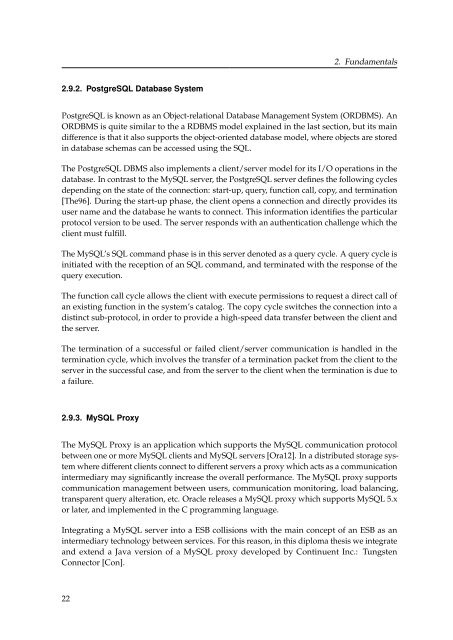Diploma Thesis Santiago Gómez Sáez - IAAS
Diploma Thesis Santiago Gómez Sáez - IAAS
Diploma Thesis Santiago Gómez Sáez - IAAS
Create successful ePaper yourself
Turn your PDF publications into a flip-book with our unique Google optimized e-Paper software.
2. Fundamentals<br />
2.9.2. PostgreSQL Database System<br />
PostgreSQL is known as an Object-relational Database Management System (ORDBMS). An<br />
ORDBMS is quite similar to the a RDBMS model explained in the last section, but its main<br />
difference is that it also supports the object-oriented database model, where objects are stored<br />
in database schemas can be accessed using the SQL.<br />
The PostgreSQL DBMS also implements a client/server model for its I/O operations in the<br />
database. In contrast to the MySQL server, the PostgreSQL server defines the following cycles<br />
depending on the state of the connection: start-up, query, function call, copy, and termination<br />
[The96]. During the start-up phase, the client opens a connection and directly provides its<br />
user name and the database he wants to connect. This information identifies the particular<br />
protocol version to be used. The server responds with an authentication challenge which the<br />
client must fulfill.<br />
The MySQL’s SQL command phase is in this server denoted as a query cycle. A query cycle is<br />
initiated with the reception of an SQL command, and terminated with the response of the<br />
query execution.<br />
The function call cycle allows the client with execute permissions to request a direct call of<br />
an existing function in the system’s catalog. The copy cycle switches the connection into a<br />
distinct sub-protocol, in order to provide a high-speed data transfer between the client and<br />
the server.<br />
The termination of a successful or failed client/server communication is handled in the<br />
termination cycle, which involves the transfer of a termination packet from the client to the<br />
server in the successful case, and from the server to the client when the termination is due to<br />
a failure.<br />
2.9.3. MySQL Proxy<br />
The MySQL Proxy is an application which supports the MySQL communication protocol<br />
between one or more MySQL clients and MySQL servers [Ora12]. In a distributed storage system<br />
where different clients connect to different servers a proxy which acts as a communication<br />
intermediary may significantly increase the overall performance. The MySQL proxy supports<br />
communication management between users, communication monitoring, load balancing,<br />
transparent query alteration, etc. Oracle releases a MySQL proxy which supports MySQL 5.x<br />
or later, and implemented in the C programming language.<br />
Integrating a MySQL server into a ESB collisions with the main concept of an ESB as an<br />
intermediary technology between services. For this reason, in this diploma thesis we integrate<br />
and extend a Java version of a MySQL proxy developed by Continuent Inc.: Tungsten<br />
Connector [Con].<br />
22

















